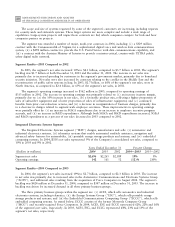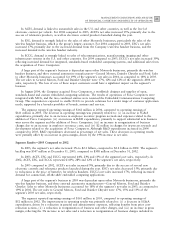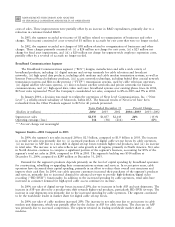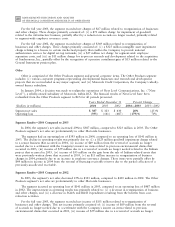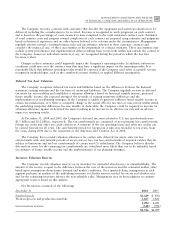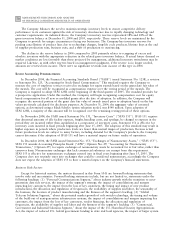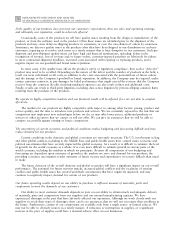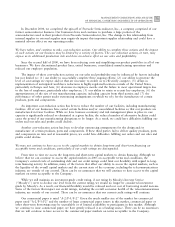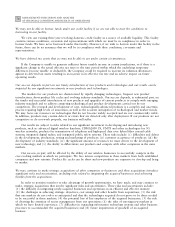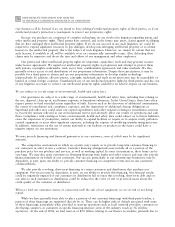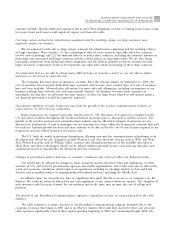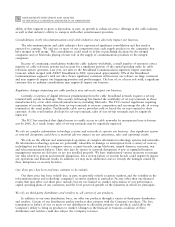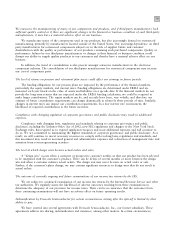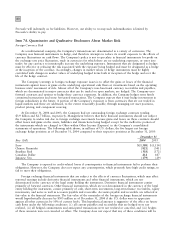Motorola 2004 Annual Report Download - page 78
Download and view the complete annual report
Please find page 78 of the 2004 Motorola annual report below. You can navigate through the pages in the report by either clicking on the pages listed below, or by using the keyword search tool below to find specific information within the annual report.
70 MANAGEMENT'S DISCUSSION AND ANALYSIS
OF FINANCIAL CONDITION AND RESULTS OF OPERATIONS
The Company balances the need to maintain strategic inventory levels to ensure competitive delivery
performance to its customers against the risk of inventory obsolescence due to rapidly changing technology and
customer requirements. As indicated above, the Company's inventory reserves represented 18% and 22% of the
gross inventory balance at December 31, 2004 and 2003, respectively. These reserve levels are maintained by the
Company to provide for unique circumstances facing our businesses. The Company has inventory reserves for
pending cancellations of product lines due to technology changes, long-life cycle products, lifetime buys at the end
of supplier production runs, business exits, and a shift of production to outsourcing.
The decline in the reserve balance in 2004 compared to 2003 primarily relates to scrapping of excess and
obsolete inventory with the appropriate reduction in the related gross inventory balance. If actual future demand or
market conditions are less favorable than those projected by management, additional inventory writedowns may be
required. Likewise, as with other reserves based on management's judgment, if the reserve is no longer needed,
amounts are reversed into income. There were no signiÑcant reversals into income of this type in 2004.
Recent Accounting Pronouncements
In December 2004, the Financial Accounting Standards Board (""FASB'') issued Statement No. 123R, a revision
to Statement No. 123, ""Accounting for Stock-Based Compensation.'' This standard requires the Company to
measure the cost of employee services received in exchange for equity awards based on the grant date fair value of
the awards. The cost will be recognized as compensation expense over the vesting period of the awards. The
Company is required to adopt SFAS 123R at the beginning of the third quarter of 2005. The standard provides for
a prospective application. Under this method, the Company will begin recognizing compensation cost for equity
based compensation for all new or modiÑed grants after the date of adoption. In addition, the Company will
recognize the unvested portion of the grant date fair value of awards issued prior to adoption based on the fair
values previously calculated for disclosure purposes. At December 31, 2004, the aggregate value of unvested
options, as determined using a Black-Scholes option valuation model, was $540 million. Upon adoption of
SFAS 123R, a majority of this amount will be recognized over the remaining vesting period of these options.
In November 2004, the FASB issued Statement No. 151, ""Inventory Costs'' (""SFAS 151''). SFAS 151 requires
that abnormal amounts of idle facility expense, freight, handling costs, and spoilage, be charged to expense in the
period they are incurred rather than capitalized as a component of inventory costs. Statement 151 is eÅective for
inventory costs incurred in Ñscal periods beginning after June 15, 2005. The adoption of this standard may result in
higher expenses in periods where production levels are lower than normal ranges of production. Because actual
future production levels are subject to many factors, including demand for the Company's products, the Company
cannot determine if the adoption of SFAS 151 will have a material impact on future results of operations.
In December 2004, the FASB issued Statement No. 153, ""Exchanges of Nonmonetary Assets,'' (""SFAS 153'').
SFAS 153 amends Accounting Principles Board (""APB'') Opinion No. 29, ""Accounting for Nonmonetary
Transactions,'' (Opinion 29) to require exchanges of nonmonetary assets be accounted for at fair value, rather than
carryover basis. Nonmonetary exchanges that lack commercial substance are exempt from this requirement.
SFAS 153 is eÅective for nonmonetary exchanges entered into in Ñscal years beginning after June 15, 2005. The
Company does not routinely enter into exchanges that could be considered nonmonetary, accordingly the Company
does not expect the adoption of SFAS 153 to have a material impact on the Company's Ñnancial statements.
Business Risk Factors
Except for historical matters, the matters discussed in this Form 10-K are forward-looking statements that
involve risks and uncertainties. Forward-looking statements include, but are not limited to, statements under the
following headings: (1) ""Personal Communications Segment,'' about industry growth with the transition to next-
generation data rich services, the impact of the segment's strategy, the impact of consolidations and mergers
impacting key customers, the impact from the loss of key customers, the timing and impact of new product
introductions, the allocation and regulation of frequencies, the availability of supplies and labor, the seasonality of
the business, the location of product manufacturing and the Ñrmness of the segment's backlog; (2) ""Global
Telecom Solutions Segment,'' about the potential market growth of soft switch technology, the timing and volume
of the build-out of next-generation infrastructure systems, the impact of consolidations and mergers impacting key
customers, the impact from the loss of key customers, vendor Ñnancing, the allocation and regulation of
frequencies, the availability of supplies and labor and the Ñrmness of the segment's backlog; (3) ""Commercial,
Government and Industrial Solutions Segment,'' about the impact of the U.S. Homeland Security Appropriations
Act, the impact of reduced U.S. federal government funding to state and local agencies, the impact of larger system


